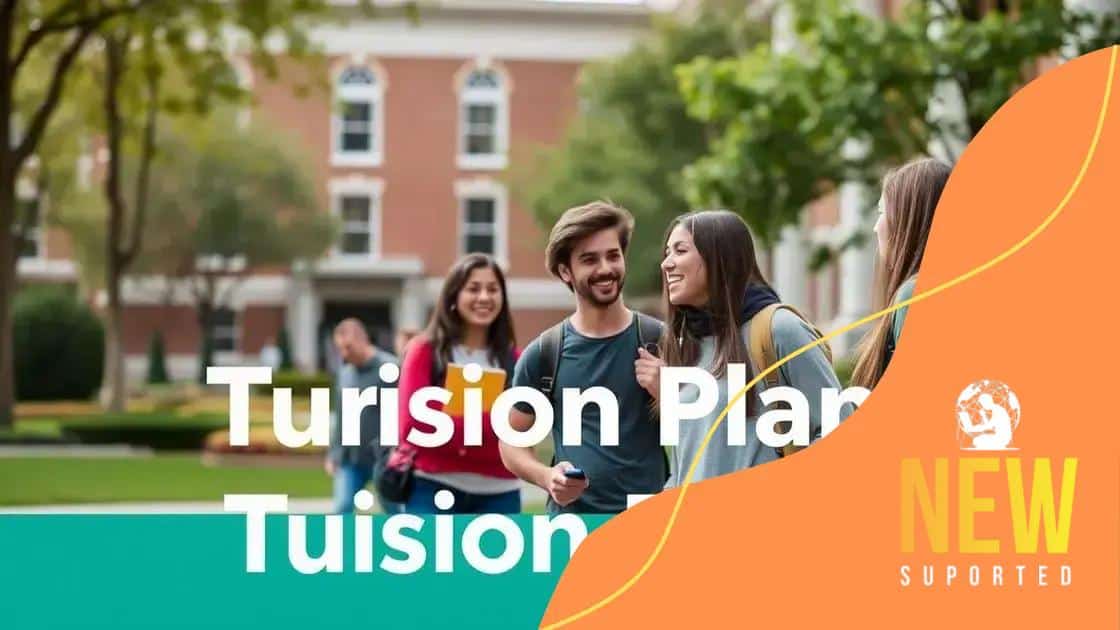How universities are addressing the rising cost of tuition

Universities are addressing the rising cost of tuition through innovative funding models, partnerships with financial institutions, scholarships, and income-driven repayment plans to reduce student debt and improve educational accessibility.
How universities are addressing the rising cost of tuition is a pressing issue for many families today. With education expenses on the rise, it’s essential to explore what institutions are doing to make learning more affordable. Have you wondered how these changes might affect your future?
Understanding the factors driving tuition increases
Understanding the factors driving tuition increases is essential for students and families making educational choices today. With costs rising, it’s vital to explore why tuition has skyrocketed at many universities.
Key Factors Behind Rising Tuition
Several elements contribute to the increasing cost of tuition. These factors include:
- State funding cuts: Many universities face reduced financial support from state governments, leading them to raise tuition to cover lost revenue.
- Increased demand for services: As student needs grow, many institutions expand their services, from mental health support to enhanced facilities, which comes at a cost.
- Administrative expenses: The number of administrative staff and associated costs have increased, contributing to the overall tuition hikes.
- Technological advancements: Investing in technology for learning and campus services is necessary but can also lead to higher fees.
Furthermore, the economic environment significantly impacts tuition rates. For instance, during economic downturns, institutions may rely more on tuition revenue to sustain operations. Additionally, universities compete for high-achieving students, leading to increased spending on marketing and recruitment.
Long-Term Trends
Long-term trends also play a role. Over the past few decades, tuition has consistently outpaced inflation. This reality can be alarming for prospective students who already face daunting student loan debt. Understanding these trends helps families plan and seek resources or alternatives.
Another important aspect is the discrepancy between public and private institutions. Private universities often have higher baseline tuition rates, while public colleges rely on state funding, affecting the overall affordability. Being aware of these differences can aid in making informed decisions about education.
In conclusion, addressing the factors driving tuition increases is key to navigating the challenging landscape of higher education. Awareness of these issues can empower families to seek the best financial options available.
Innovative funding models for universities
Innovative funding models for universities are becoming increasingly vital as traditional sources of revenue shrink. Many institutions are exploring creative strategies to maintain financial stability without over-burdening students with debt.
Public-Private Partnerships
One innovative approach is forming public-private partnerships (PPPs). These collaborations allow universities to share resources and infrastructure with private companies. This can lead to:
- Shared services: By collaborating, universities can provide essential services more efficiently.
- Capital funding: Private firms can invest in campus improvements, easing the financial load on institutions.
- Research opportunities: Partnerships can lead to joint research initiatives, boosting innovation.
Another emerging model is the implementation of revenue-sharing agreements. These agreements help universities benefit financially from research commercialization. When a university develops a new product or technology, the resulting profits can support various aspects of the institution.
Crowdfunding and Alumni Engagement
Crowdfunding has gained traction as a funding source, allowing universities to tap into the strengths of their communities. By inviting alumni and supporters to contribute, schools can finance specific projects, scholarships, or initiatives. This approach not only raises funds but also strengthens community ties.
Additionally, fostering strong alumni relations can create a consistent funding stream. Universities can engage past graduates through:
- Scholarship funds: Alumni contributions can be directed to help students financially.
- Networking events: Hosting events encourages alumni to give back and stay connected to their alma mater.
- Capital campaigns: Targeted fundraising efforts can lead to significant donations for critical projects.
The future of university funding may also involve embracing technology. Innovations like blockchain could streamline donations and enhance transparency. By adopting new tools, universities can attract a broader range of donors who wish to see the impact of their gifts.
Scholarship programs that make a difference

Scholarship programs that make a difference play a crucial role in making higher education accessible to students from various backgrounds. These programs help alleviate the financial burden on families while encouraging academic achievement and community involvement.
Types of Scholarships
There are various types of scholarships available for students, each designed to support different needs. Understanding these options can help students choose the right ones for their situations. Common types include:
- Merit-based scholarships: Awarded to students demonstrating exceptional academic, artistic, or athletic abilities.
- Need-based scholarships: Designed for students who require financial assistance due to their economic situation.
- Community service scholarships: Given to students who actively engage in volunteer work and contribute to their communities.
- Targeted scholarships: Aimed at specific groups, such as minorities, women, or students pursuing specific fields.
Scholarships not only provide financial relief but also foster a sense of belonging and community. Many universities partner with organizations and donor alumni to create scholarships that reflect the values and needs of their student bodies.
Impact on Students’ Lives
The impact of scholarship programs on students’ lives can be profound. Many recipients report that financial support allows them to focus more on their studies rather than struggling to cover tuition fees. This shift often leads to improved academic performance and graduation rates.
Additionally, scholarships promote diversity within university settings. When students from various backgrounds receive support, it enhances the overall educational experience for everyone. Different perspectives foster creativity and innovation, preparing all students for a diverse workforce.
Universities also benefit from these programs. Scholarships can improve enrollment numbers and retention rates, contributing to the institution’s reputation. As a result, schools are increasingly investing in scholarship opportunities to attract and retain talented students.
The role of online education in cost reduction
The role of online education in cost reduction is increasingly significant in today’s learning environment. As tuition rates rise, many students look to online programs as an economical alternative to traditional education.
Lower Operational Costs
One major advantage of online education is its potential for lower operational costs. By conducting classes online, universities can save on various expenses, such as:
- Facility costs: Online programs reduce the need for physical classroom space, leading to savings on maintenance and utilities.
- Reduced staff expenses: Institutions can minimize hiring additional staff for classroom management.
- Flexible scheduling: There are fewer constraints regarding classroom schedules, which can optimize resource use.
These savings can be passed on to students in the form of lower tuition, making education more affordable.
Accessibility and Course Variety
Online education also increases accessibility for students who may not have been able to attend traditional classes. Students can learn from anywhere and access a broader range of courses that may not be available in their local institutions. This flexibility often leads to:
- Wider course selection: Students can enroll in programs from universities around the world without relocating.
- Accommodations for working students: Online education allows individuals to balance their studies with jobs or family commitments.
- Self-paced learning: Many online courses allow students to learn at their own speed, which can help reduce costs associated with repeated courses.
By providing a choice between asynchronous and synchronous learning models, online education caters to diverse learning styles and personal circumstances, ultimately supporting a more inclusive academic environment.
Furthermore, as technology improves, online education platforms are becoming more efficient and user-friendly. Enhanced learning environments often lead to better student outcomes without the added cost typically associated with traditional instruction. For many, this represents not just a financial savings but also a chance to succeed.
Student debt relief strategies initiated by universities
Student debt relief strategies initiated by universities play a critical role in helping graduates manage their financial burdens. As student loan debt continues to grow, many institutions are taking proactive steps to provide support and solutions.
Partnerships with Financial Institutions
One effective strategy is forming partnerships with financial institutions. These collaborations can offer:
- Lower interest rates: By working with banks and credit unions, universities can help students secure loans with reduced rates.
- Financial literacy programs: Many schools are working with financial organizations to provide workshops that educate students on managing debt and budgeting.
- Loan repayment assistance: Some universities offer programs that assist graduates with loan payments for a fixed period after graduation.
These initiatives not only alleviate financial stress but also empower students to make informed financial decisions.
Income-Driven Repayment Plans
Many universities are promoting income-driven repayment plans as an option for graduates. This approach allows students to pay back loans based on their income, which can be beneficial during the early years of their careers. Advantages of income-driven repayment include:
- Affordability: Payments are capped based on income, making it easier for graduates to manage their monthly expenses.
- Loan forgiveness options: After a certain number of years in the program, the remaining debt may be forgiven.
- Flexibility: Changes in income, such as job loss or lower wages, can adjust the repayment amount.
By making information about these plans readily accessible, universities support their graduates in managing their debt responsibly.
Additionally, some institutions are creating innovative scholarship programs specifically aimed at reducing debt burdens. These scholarships are awarded to students who commit to specific fields or community service roles after graduation. This approach not only helps students afford their education but also encourages them to give back to the community, creating a cycle of support and sustainability.
In conclusion, universities are actively addressing the rising cost of tuition and student debt through innovative strategies. From developing partnerships with financial institutions to offering income-driven repayment plans and scholarships, these efforts are making a significant impact. By exploring these options, students can find support that eases their financial burdens. As education continues to evolve, these initiatives will play a crucial role in shaping the future of accessible and affordable learning for all.
\n
\n
FAQ – Frequently Asked Questions About Tuition Costs and Debt Relief
What are some strategies universities use to reduce tuition costs?
Universities implement strategies like partnerships with financial institutions, innovative funding models, and offering online education to help reduce costs.
How do scholarships help students manage their debt?
Scholarships provide financial assistance that reduces the amount students need to borrow, helping them graduate with less debt.
What is an income-driven repayment plan?
An income-driven repayment plan is a loan repayment option where monthly payments are based on the borrower’s income, making it more manageable.
Can universities offer partnerships for student loans?
Yes, many universities collaborate with banks to offer lower interest rates and better terms for student loans, easing the financial burden.






